Are You A Vanguard? Applications Now Open
AP Photo/Pat Sullivan
This is your first of three free stories this month. Become a free or sustaining member to read unlimited articles, webinars and ebooks.
Become A MemberLike the first few wrinkles to appear on a young face, the bayous that traverse the city of Houston carve slight depressions in the city’s otherwise flat landscape. They are rivers that never quite became rivers. Rather than carrying fresh water down from higher elevations, bayous are channels for the inflow of high tide and the overflow of stormwater.
The Bayou City’s relationship with its namesake has been uneven. Several decades ago, many bayous were encased in concrete, thought then to be the best way to control stormwater. In recent years, they’ve been turned into centerpieces of a parks system emphasizing access to urban green space.
But in mid-April, even the region’s 2,500 miles of bayous weren’t enough when intense rain, up to 17 inches one day, fell on Houston. Some neighborhoods on the city’s north side were inundated. Waters in one area reached 40 feet above their previous record flood levels. Eight people died, and damage is estimated at over $5 billion. For a few days, the city that welcomed New Orleans refugees post-Katrina was itself the victim of a watery disaster. The scale is much different but, as with the Louisiana city’s 2005 flooding, Mother Nature wasn’t solely to blame.
As Houston’s economy has boomed — petrochemicals, medicine and the energy industry have combined with a relatively low cost of living to create one of the country’s great economic success stories — developers have capitalized on swaths of flat land to provide housing for an influx of newcomers.
April’s floods, the second such event in less than a year, threaten the prosperity. Thousands of square miles of largely unplanned hardscape leave stormwater with precious few places to go.
“[Flooding is] a reflection of sprawl and kind of lack of developmental controls in terms of where people built and how closely people can build inside of floodplains,” says Jaime Gonzalez, community conservation director at the Katy Prairie Conservancy. “We keep on chipping away at the shield of the city.”
At 600 square miles, Houston proper is the largest major city by land area in the U.S. Beyond the city limits, the nine-county metro area extends as far as development capital and consumer demand allows. Nary a mountain, river, coastline or lake gets in the way.
Neither do many regulations. Houston is famous among urban planners as the only major U.S. city without conventional zoning, which typically dictates what types of land uses can go where. The market decides what to build. “Sprawl” is no dirtier a word than “petroleum” (or “hydrocarbons” in local vernacular), and residents gladly consume the region’s signature product. Both the city and its suburbs are defiantly spread out and auto-oriented.
“It’s really a perfect storm of economics, population and land use,” says Matthew Festa, professor at South Texas College of Law.
However, beyond the cost of life and recovery due to April’s floods, that “perfect storm” is becoming increasingly unsustainable.
Since 1980, the region grew from 3.3 million to 6.1 million, gaining about 160,000 new residents in 2015 alone. That figure means that the greater Houston area, which represents nearly 2 percent of the American population, captured 6 percent of nationwide urban growth last year. By some estimates, Harris County is expected to add over 1.5 million residents by 2040, with Houston proper rising from 2.4 million to 3 million.
Such growth calls for something slightly more strict than laissez-faire planning — particularly for a place positioning itself to be America’s great 21st-century metropolis. In September, the city did adopt its first general plan. Called Plan Houston, it arrives like the blueprint to a building already half built. Addressing far more than land use, Plan Houston covers everything from economic development to education to public health to arts and culture. It acknowledges 140 existing studies, neighborhood plans, parks plans and other previous planning efforts.
Lest anyone get nervous about big government, the plan’s preamble insists it “is not about establishing land use controls.” The majority of its 32 stated “goals and topics” do not, strictly speaking, have anything to do with land use at all, and include phrases like “affordable, high-quality health care for all,” “internationally recognized cultural and entertainment opportunities,” “a diverse, welcoming culture,” and “a culture that encourages innovation.”
Plan Houston is billed as a “consensus” document that will presumably lead to consistency and coordination in future initiatives.
“We have not yet determined what we’re targeting,” says Patrick Walsh, the city’s planning director. “We’ve said that we want to encourage compact, walkable development around transit. That’s great that we’ve decided that, but we have not yet figured out the best path for encouraging that to happen.”
If developers heed Plan Houston’s encouragement, the derision that Houston has suffered from outsider aesthetes may turn out to be misplaced — the result of premature judgment of a city still in its infancy. In other words, Houston’s sprawl may just be density that hasn’t happened yet.
Ideally, the plan would also be a guiding force to make the city more functional and more livable while accommodating growth, maintaining the region’s economic prosperity, and keeping cost of living manageable, especially for disadvantaged populations. All while keeping disastrous flooding at bay.
Houston’s expansion is going in two directions at once. While development on the suburban fringe continues, there is intense focus on the urban core.
According to the Houston Area Survey published last month by Rice University’s Kinder Institute, fully half of the respondents said they prefer a walkable urban lifestyle to a suburban one. That still leaves plenty of people to fill the master-planned communities and subdivisions going up on the outskirts. But it also indicates that many Houstonians want amenities that only a denser city can offer.
The evidence of the demand is plain: From 2013 to 2014, the average home price in the city of Houston rose from $248,000 to $270,000. That $22,000 is a small step compared to many American cities, but a giant leap for Houston. Even with a slight drop this year, increases like that demonstrate that cheap housing might not be a limitless resource.
Many longtime city residents are understandably nervous, eyeing new development as a threat that could price them out of neighborhoods that have historically been affordable. Along with continuing to lure newcomers, can the city, as it gentrifies, avoid displacing low-income people?
Inside the 610 Loop, the innermost of the region’s three beltways, the city has already made it easier to subdivide single-family lots into duplex townhouses. Those have proliferated in upscale neighborhoods west of downtown for the past decade. They are now pushing in to the east side neighborhoods that have historically been home to minority populations and low property values.
Signs of hipster-oriented gentrification are already apparent. Beer gardens have arisen on formerly blighted corners. “Maker spaces” have moved into old factories. Artists are finding the sweet spot where they can afford studio space but have neighbors who can afford their work. There’s talk of pop-up swimming pools.
That’s a radical change for Houston, which historically lost mobile young professionals to coastal cities and neighboring Austin.
“I think that it’s one of the few cities where you can just show up and not have legacy, or have the right family name or the right connections, and you can just go and people will just accept you,” says Jeff Kaplan, a Houston native who is establishing a workshop to build non-toxic furniture in the Greater East End.
But what is one developer’s efficient use of space is an existing resident’s warning sign.
“Taking down one house, one old house, on the lot and putting six townhomes is what I call the ‘Houston default redevelopment scenario,’” says Diane Schenke, president of the Greater East End Management District, an economic development organization.
The Midtown area, just south of downtown, has been transformed by large multifamily apartment buildings in just the past five years. Absent the strict land use controls and historic preservation laws that govern many cities, those developments erased much of Freedmen’s Town, a historic African-American neighborhood.
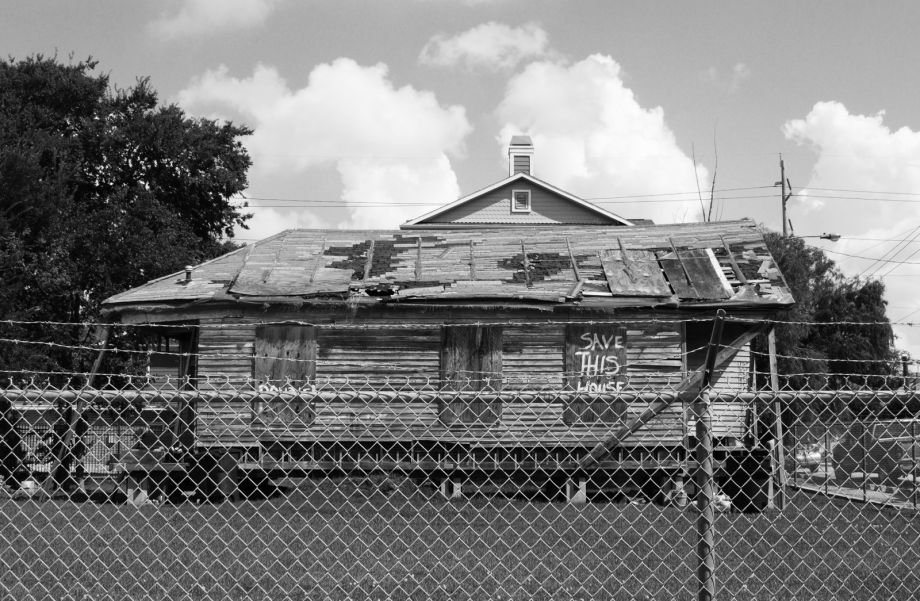
Many houses in Freedmen's Town, a post-Civil War community of African-Americans, were demolished to make room for new developments. (Photo by Patrick Feller on flickr)
Though many east side residents own their homes — and have for decades — if higher land values bring higher real estate taxes, a retiree might end up with a tax bill that exceeds whatever pension or Social Security income he or she receives.
“We saw a lot of prices really rise dramatically in a very short amount of time, especially in some of our highly sought-after urban communities,” says Walsh. “As those prices went up, we saw some of the more mixed-income communities becoming more monolithic.”
A comparison of 2012 and 2000 census data for one east side neighborhood showed dramatic changes: Median household incomes rose from $14,493 to $38,936 while the African-American population fell from 79 percent to 65 percent and the white population doubled. The area’s population fell from 15,436 to just over 14,000.
“Developers kind of jumped on the higher-income bandwagon,” says Antoine Bryant, an architect and member of the Houston Planning Commission. “What does that mean for the young professional that’s actually from Texas, or, God forbid, the working-class person that’s from Texas?”
So far, the city has tightened some historic preservation regulations and has established assistance programs for seniors, but planners are loath to interfere too much with the free market.
There’s a major difference, though, between the east side of Houston and gentrifying areas in other cities, such as Los Angeles’ Echo Park, San Francisco’s Mission District or New York’s Williamsburg: Even Houston’s most central neighborhoods still have room to spare. Kathy Payton, president of the Fifth Ward Redevelopment Corp., a community development nonprofit, estimates that among the Fifth Ward’s largely low-income population of 28,000, there are around 3,000 vacant lots. That number doesn’t include properties that are occupied but dilapidated. With trademark Texas roominess, in some ways, the economics of gentrification are entering unknown, and possibly more auspicious territory in Houston. Maybe Houstonians can embrace a new model, in policy and spirit, before tensions spin out of control.
“If you move into a neighborhood because of its location and then automatically push for there to be four more juice bars … have you moved in because you liked the area or have you moved in just because of where it is?” chides Bryant.
Many community leaders recognize the opportunity that new development represents, but they don’t want welcome it unconditionally.
“The goal should be to fill that infill with opportunities that include affordable housing for the indigenous community as well as market-rate opportunities to attract newcomers,” says Payton.
Plan Houston acknowledges these concerns. It doesn’t yet include solutions. “Plan Houston sets up the broad framework for balancing how to raise up our underserved communities while keeping them affordable so that local residents can remain in place,” Walsh explained via email.
In that respect, the city may be entering new territory, especially since it hasn’t historically had to promote subsidized housing. The market has taken care of new housing, and distressed neighborhoods have, for better or worse, remained affordable for the city’s poorest residents.
“We’re looking at it overall as this two-pronged approach: One is providing opportunities in our distressed areas for reinvestment,” writes Walsh. “But [the city is] also looking at placing affordable housing in some of our high-opportunity areas and offering assistance to those that need it.”
Gentrification is less concerning, of course, if the economic tide lifts everyone. That requires, in part, good jobs for residents who might otherwise be priced out of their own neighborhoods.
From an employment perspective, Houston’s dependence on hydrocarbons is somewhat exaggerated. Jobs directly related to extraction numbered 64,000 in December 2014 and were falling with the drop in oil prices. Manufacturing jobs numbered 260,000 — also with a slight decline — and were recently passed up by jobs in leisure and hospitality. Meanwhile, education and healthcare — buoyed by institutions like Rice University and the Texas Medical Center, the largest hospital and research complex in the United States — represent more jobs than extraction and manufacturing combined. (Rice University’s Kinder Institute for Urban Research is host of the 2016 Next City Vanguard conference.)
The region’s unemployment rate in February stood at 4.7 percent, up from 4.3 percent a year earlier. Even so, 62 percent of respondents to the 2016 Houston Area Survey said that the region’s job opportunities are “excellent” or “good,” with a similar number predicting that their personal financial situations are improving.
This doesn’t mean, though, that Houstonians are gaining jobs. For every job created in the region, there are migrants – interregional, interstate and international – who are eager to compete for them. Often, the city’s poorest residents are left out.
“We’re importing talent,” says Claudia Aguirre-Vasquez, senior vice president at Neighborhood Centers, a Houston nonprofit that advocates for low-income residents. “We put a ceiling on top of the people that are here.”
Many members of Houston’s ethnic minorities live in a different economic world than their middle-class neighbors. Unemployment among Latinos, Asians and African-Americans is higher than it is among white residents. Wages at the low end of the income spectrum have stagnated or even declined. Moreover, inequality is rising. According to a study by PolicyLink and the USC Program for Environmental and Regional Equity, the Houston region ranked 100th in income inequality among the nation’s 150 largest metro regions in 1979. Today, it ranks 13th.
As cost of living rises in formerly inexpensive center city neighborhoods, many in the region see education and job training as the best way to regain a semblance of equity. A Georgetown University study reports that by 2018, 34 percent of Texas’ jobs will require an associate’s degree or above. Yet, only 29 percent of the region’s African-Americans, 21 percent of U.S.-born Latinos and 11 percent of Latino immigrants have at least that level of education.
“The biggest challenge for this region is the middle-skills gap,” says Aguirre-Vasquez. “With just a little bit of investment in the human capital we have in this region, we can address those thousands of jobs that go unfilled each year.”
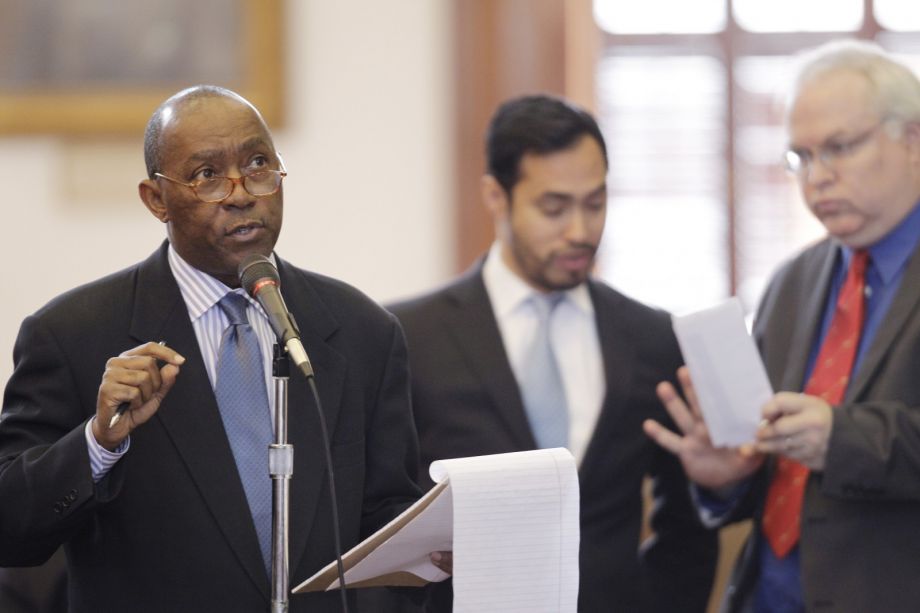
Mayor Sylvester Turner took office in January. (AP Photo/Eric Gay)
Houston Mayor Sylvester Turner, who took office in January, ran on a platform that included a minimum wage raise. But state law in politically conservative Texas explicitly prohibits cities alone from raising local rates above the current statewide minimum of $7.25 an hour (the federal mandate). However, income equality advocates are still pushing for a hike, and some Democrats in the state legislature have also made attempts to pass an increase.
With that strategy in limbo, the city is turning to a popular incentive in Texas: the tax break. In March, the city council approved “guidelines” that enable the city to provide certain tax breaks to companies that hire local workers. These breaks can go to, among others, developers of affordable housing, thus linking job creation with housing supply.
To assess Houstonians’ deepest fears, the most recent Houston Area Survey asked an open-ended question: “What would you say is the biggest problem facing people in the Houston area today?”
Nearly one-third said traffic.
Previous surveys revealed concerns that were arguably more harrowing. In 1987, 71 percent cited economic woes. In 1994, 70 percent named crime. This year’s survey lists both of those concerns at 21 percent. In many ways, the responses mirror the city’s prosperity. The economic boom has meant less desperation, more residents and more cars on the road. Traffic is a sign of economic vibrancy, especially when many Houstonians have no alternative.
“We have been fairly successful at a traditional car-centric approach to providing access and mobility to our residents,” says Walsh.
That’s an understatement. With 16.4 public transit trips per capita per year as of 2013, Houston ranks 91st out of 290 cities included in a National Transit Database study. Philadelphia, with a comparable metro population, ranks 10th, with 68 trips per capita. That means that as the Houston region adds population, it adds a disproportionately high number of car trips.
“What is arguably the most oil-dependent city in the world — in more ways than one — could eventually be one of the greenest.”
By some measure, this number won’t be going down any time soon. The Texas Department of Transportation is hard at work building Houston’s third ring road, a 180-mile superhighway serving the city’s outer suburbs and edge cities. The sixth and northernmost segment opened in March, with more on the way.
At the same time, city leaders are going to great lengths to discourage driving, especially within the relatively intimate 610 Loop.
Last August, Houston Metro made the audacious move of retooling its entire bus network literally overnight. It scrapped a network that had been in place since the 1970s; new routings and schedules were designed to maximize ridership and reflect commuting patterns — without significantly increasing its budget. As of March, monthly ridership was up 4 percent — at a time when public transit ridership is down in many cities. (Despite Metro’s promised efficiencies, some residents of low-income communities protested the redesign, claiming that it sacrificed the needs of many transit-dependent riders. Ultimately, the Metro board voted to spend $10 million, of a roughly $300 million budget, to salvage some lines that were to have been eliminated.)
However radical the retooled bus system is, it is nothing compared to the expansion of the city’s light-rail network.
Last May, the east-west Green Line opened along the median of Harrisburg Boulevard and through the East End, and the southeast Purple Line opened connecting downtown with local universities. Extensions are under construction. Monthly rail ridership is up 24 percent from March 2015.
Rather than shuttle white-collar commuters into a central business district from suburban areas, Houston’s lines are designed to take city-dwellers from one urban neighborhood to others. Some of the city’s poorest neighborhoods are now in easy reach of its biggest employment centers. The new east side lines give residents access not only to downtown but also to the University of Houston and the Texas Medical Center, the latter of which is the largest medical center in the world. Its employment base of 106,000 is bigger than that of all but a handful of American downtowns.
“Houston ended up with probably the most interesting rail system in the country in that it really is concentrated on the urban core,” says Zakcq Lockrem, director of planning at planning firm Asakura Robinson, which has offices in Austin and Houston. “It’s about urban people living an urban life.”
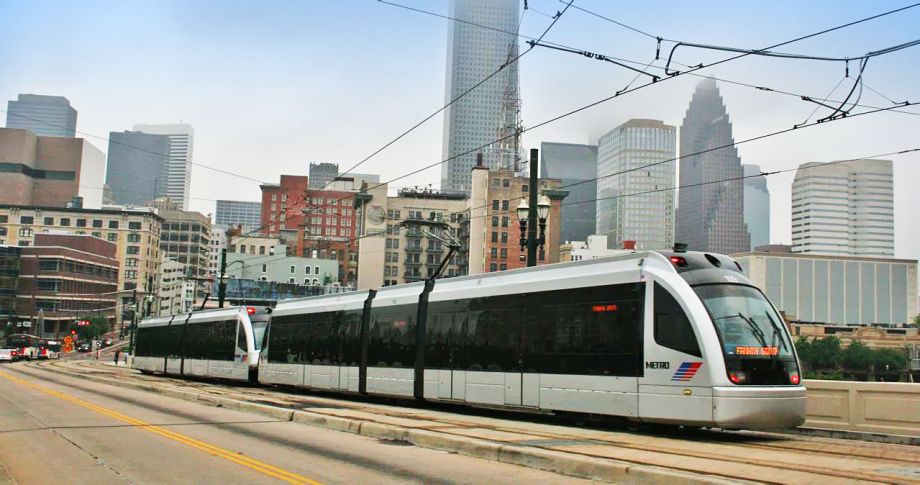
Houston light rail (Photo by Jackson Myers)
Even so, light rail has spurred little transit-oriented development so far. Station platforms sit across from vacant lots, and few surroundings buildings are taller than one story. Almost every commercial and residential structure in the city comes with parking.
Nevertheless, in the absence of a binding general plan, the rail lines serve as de facto guides to future development. If Houston is to densify, rail lines may prevent a larger population from adding to the traffic headaches. By promoting dense development, the train could also be the catalyst that protects existing residents while still enabling new ones to move in — not one house or townhouse at a time, but, possibly, dozens and hundreds of apartments at a time.
“We’ve got a 3-, 4-mile line with a lot of neighborhoods adjacent and most of those are just single family,” says Schenke.
While dense development and mixed incomes might seem like radical notions in Houston, they’re no more radical than public transit is, so the two may be able to go hand in hand. Plan Houston “encourage(s) compact, pedestrian-friendly development around transit.” But, given the pace of development in the city, developers may get there before the ripple effects of those guidelines take hold — for better or worse. So far, they are leaning toward luxury housing, planned before the adoption of Plan Houston and before the city began emphasizing affordable housing. Bryant says he is concerned about “a glut of Class A multifamily about to come online in the next 12 months, and a decrease of the availability of moderate-income, workforce-affordable housing both for single family and for multifamily.”
The city is also in the process of adopting a bicycle plan designed to appeal to commuters and recreational cyclists alike. Indeed, Houston is half-perfect for cycling: Though it is hot and humid, it is also flat.
Multimodal progress is complemented by the new mayor. In February, Turner made a speech to the Texas legislature that has already become legend for its rebelliousness. He called for a “paradigm shift” in the state’s approach to mobility, warning that “the traditional strategy of adding capacity, especially single-occupant-vehicle capacity on the periphery of our urban areas … are not creating the kind of vibrant, economically strong cities that we all desire.”
Houston has never been much for tree-hugging. That’s partly because it doesn’t have many trees in the first place. In recent years, though, just as Houston is discovering its city-ness, so is it discovering nature.
The city has recently opened and upgraded a series of urban parks, including Buffalo Bayou Park, Discovery Green, in the heart of downtown Houston, and the vast Memorial Park. It is upgrading Emancipation Park, a key recreational space in the Third Ward. The Bayou Greenway, when complete (and not underwater) will knit the city together with a series of trails almost as extensive as the city’s freeway system.
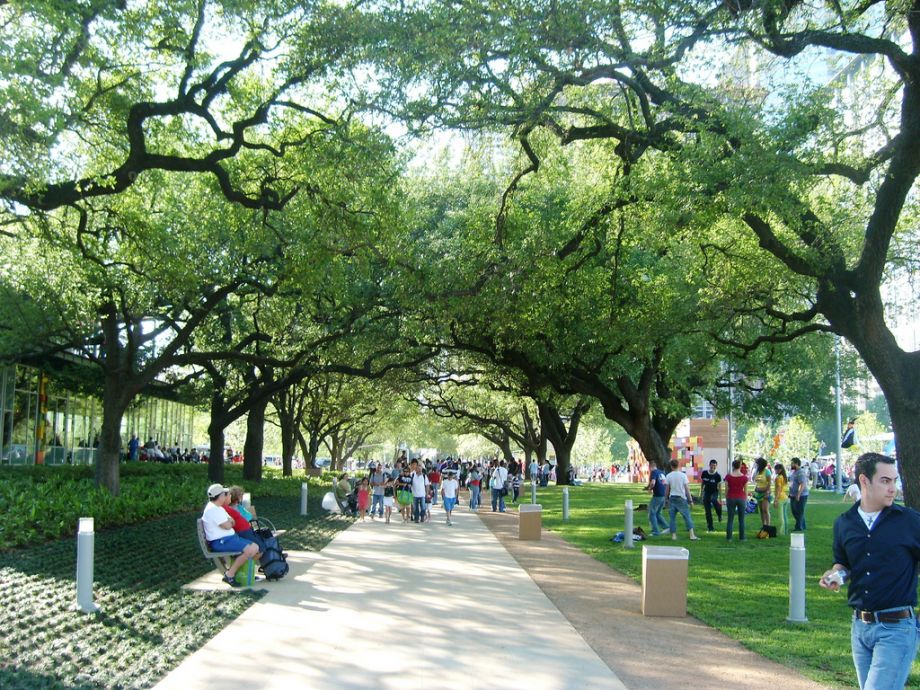
Discovery Green opened in downtown Houston in 2008. (Photo by Erion Shehaj)
Almost all of these initiatives are public-private partnerships, developed with participation from the business community, philanthropies and city government. In many ways they are the proudest symbols of the city’s embrace of the free market. As such, city leaders have not promoted, and paid for, them purely out of the goodness of their hearts. Whereas Houston residents used to content themselves with the open space in their backyards, now these urban amenities are seen as keys to attracting a talented workforce and keeping young residents happy in the city.
“Young millennials want these kind of amenities,” says Anne Olson, president of the Buffalo Bayou Partnership. “They don’t come to cities necessarily for jobs anymore. They come for quality of life. … The business community started to wake up and realize that quality of life is tied to the bottom line of business, attracting people to the city.”
Buffalo Bayou Park has been a particular hit. It is a restoration and enhancement of 2.3 miles of bayou stretching westward from downtown. A sort of sunken High Line, the park has become an instant favorite of joggers, picnickers and anyone else who wants a retreat from Houston’s hardscape. It’s the centerpiece of a network of parks and trails that, upon completion, will enhance 150 miles of Houston’s 10 major bayous through a separate initiative called Bayou Greenways 2020. Buffalo Bayou Park is located adjacent to upscale neighborhoods, but the bike paths and trails of the greenway will reach into almost every part of the city, coming within a mile-and-a-half of 1.5 million residents.
The greenway and light rail are two sides of the same coin: infrastructural elements that make the city more united, functional and attractive, especially when compared to the suburbs against which the city is competing. Further, Houston’s greening of late may be critical to its resilience. Likewise, the preservation of open space on the city’s outskirts is becoming more important in order to prevent floods from reaching the city in the first place.
“We’re spending so much money on signature parks … it’s going toward ameliorating our reputation,” says Gonzalez, of Katy Prairie Conservancy, a land trust that protects green space on the city’s western edge. “But if we go ahead and destroy all the last great wild places around Houston, that’s going to take us backwards and not forwards.”
While the localized effects of climate change are notoriously hard to predict, some models call for less overall precipitation but more intense precipitation events in Houston — precisely what occurred April 19. One study indicates that “very heavy rain events” in the region grew 16 percent more intense from 1958 to 2012. (Last week, the mayor named a former Houston city council member the city’s new “flood czar.”)
Gonzalez says that large open spaces, like the Katy Prairie, can absorb these deluges, limiting their impact on populated areas. He also says that Houston’s urban parks, though their role in the region’s ecology may be limited, make an important indirect contribution to the region’s resilience.
“The floodplain is getting larger and larger … the number of people who can potentially get flooded gets bigger,” says Gonzalez. “I don’t know if we can handle the projected growth … without densification in the middle of the city.”
In other words, welcoming nature into the city can help protect the city from nature.
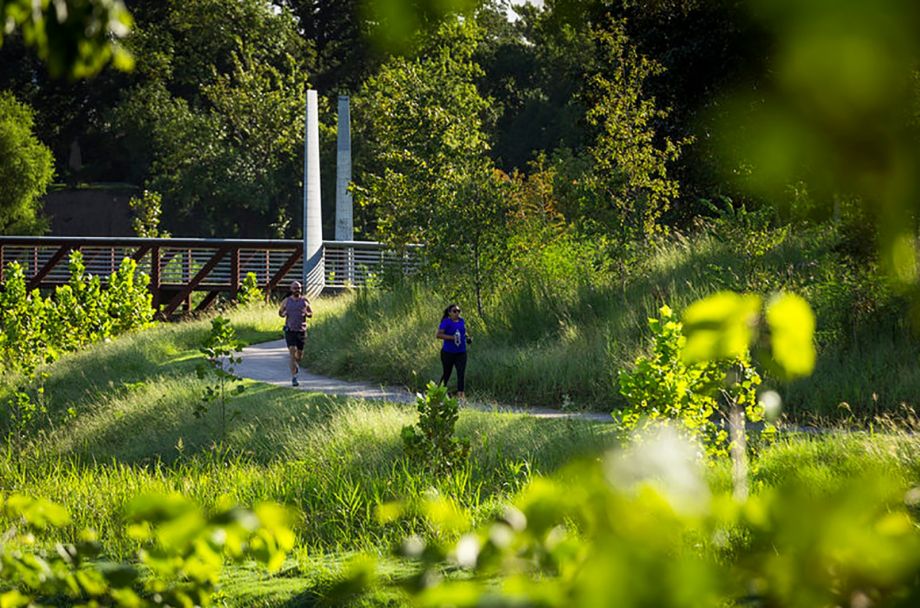
Residents run in the Buffalo Bayou Park. (Photo by Jonnu Singleton/SWA Group)
The confluence of progressive urban trends — greater density, transportation alternatives, social equity, environmentalism and the like — today may mean that Houston’s greenest, most efficient days lie ahead. Houston has potential precisely because it remains a work in progress.
Every empty lot in Houston — especially the ones near transit, in inexpensive neighborhoods — presents an opportunity to build exactly the type of developments that progressive planners recommend. Perhaps more importantly, the loose regulatory climate that has given rise to hundreds of square miles of unattractive, pedestrian-unfriendly sprawl is the very same that can permit dense, walkable, mixed-use neighborhoods.
“Houston has a wonderful opportunity because it doesn’t have an ossified, traditional Euclidean zoning structure that separates everything out by use,” says Festa. “If you want to develop mixed-use, smart growth, walkable urbanism, there are still some barriers, but you already have a head start over more traditionally zoned cities.”
The new Plan Houston includes “more emphasis on creating compact communities where people can access the kinds of things they want to access without having to get into a car,” says Walsh.
If the plan succeeds in reducing residents’ dependency on automobiles, it may also reduce pollution. Thus, what is arguably the most oil-dependent city in the world — in more ways than one — could eventually be one of the greenest.
“Our potential to allow millions of people to live affordable, low-carbon, healthy lifestyles in the next 20-year window is greater than other places,” says Jay Blazek Crossley, executive director of advocacy group and research center Houston Tomorrow. “New York City can’t add 3 million people in new houses. We can.”
Houstonians just need to get used to the idea, Walsh says, that density will be a win-win proposition.
“One thing that we’re trying to help the community understand is that in order for us to create high-value places — places that people really enjoy — the increase in density in Houston is an opportunity to achieve that,” says Walsh.
Our features are made possible with generous support from The Ford Foundation.
Josh Stephens is a freelance writer based in Los Angeles. His work has appeared in the Los Angeles Times, Planning Magazine, Sierra Magazine, the Huffington Post and the Los Angeles Review of Books. He is a contributing editor to the California Planning & Development Report and Planetizen. His website is joshrstephens.net.
Follow Josh .(JavaScript must be enabled to view this email address)

20th Anniversary Solutions of the Year magazine